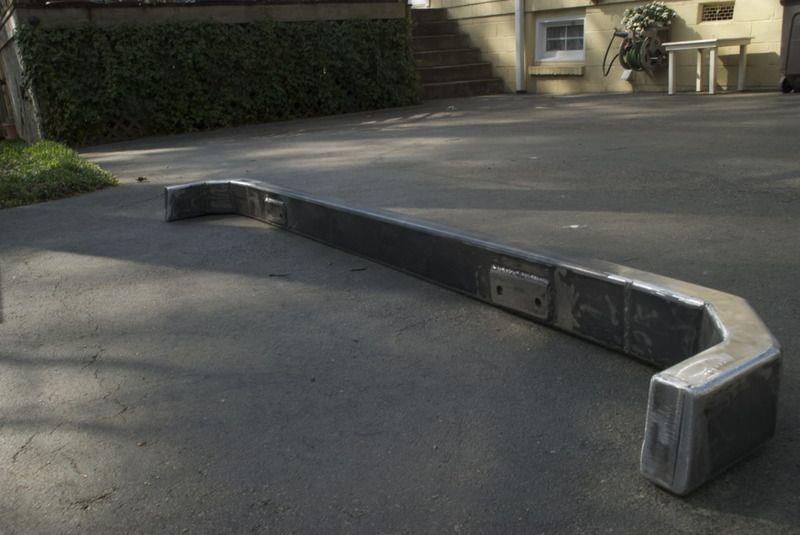sorry for the hijack, Rob ... I just *might* have had a couple beers in me and was reminiscing over old photographs when I read all the stuff on water crossings in your thread. In the Pacific Northwest there is plenty of water - deep bogs, puddles, and a few stream crossings.
Since we're here ... I thought I'd point out some of the not-so-good stuff ...
Yes, and they had a proper dual circuit (one circuit to all 4 wheel, the other to the front only), rather than a single, diagonally split system.
RRC also feature vented front rotors whereas D1's are all solid disc up front. Pre-ABS trucks from '87 and '88 are working very hard to stop 32's and the usual armor - ARB bullbar, rack, etc. My friend's 1987 could not lock up the brakes on pavement after being kitted out.
In the ABS equipped '89-95 trucks the brakes are acceptable up to narrow 33" tires, but I wouldn't be quick to over sell them for towing heavy loads over long distances in the hills, or slowing down more than 7~8" wide tire. Getting the system to work well involves a thorough flush and fluid change, and making sure the vacuum reservoir is replaced with a new and genuine LR unit. The ABS motor used to pressurize the system is expensive to replace, and frequently is burned out because of an aged or failed v. reservoir. After replacing the reservoir and upgrading all four flexible lines to braided stainless lines on the front calipers I noticed a huge improvement from when I first got the truck.
I think the extra circuit for the front brakes is something of a joke on 32" tires or larger. I blew the ABS fuse on a trail run far from the city on one outing, and the brakes were useless. Having said that, it does seem to make a great improvement when the system is fully functional

Carry spare 30 amp fuses at all times!
One more thing about the brakes: be ready for more bleed valves than you've ever seen on a passenger car. Fluid changes are NOT trivial without one of the power-bleeders. I think my 1991 counted over 10 but I can't remember what the exact number was. I just know it took a long time. And each has to be bled *in sequence*.
And don't forget the Boge Hydromat self-levelling unit in the back axle wishbone. It's how they managed such supple suspension without losing too much load-carrying capacity.
The "magic carpet" rangie ride! ... doesn't last ... They are all certainly worn out by now. My stock suspension lived for a while under hard use, then the Boge unit gave up and it started to sag very badly, bottoming out on the bumpstops while on trails. Replacing the the Boge unit is cost prohibitive. Rovers North is the only vendor I think that retails the thing in the states, and it's priced at $863 US.
A note on the engine ... the OBD1 14cux ECU is pretty simple, and there's a digital code reader built into the newer trucks under the passenger seat. However, the 3.9L motors are very finicky compared to 4.0L GEMS and bosch powered trucks. They will always, almost without fail, throw 02 sensor codes when anything is wrong. The 3.5L engine found in '87 and '88 models was a bit less prone to these kinds of troubles for some reason, but it's grossly underpowered. It seems like I was always, always chasing some little gremlin on both Rangies while the OBDII Disco fellas never had much of an issue with anything. Be warned that quite a few owners let the check engine light burn out or manually remove it because they get tired of staring at it all the time.
------
If you're not driving your DII every day as it's currently setup, it would be foolish to think of owning an RRC as a daily driver. The gas mileage is terrible, and any truck you find is going to be a bit rough on the interior. It will not be as quiet as your DII on the highway, and likely not as comfortable. The front windscreen fogs up pretty easily and the vents don't do a very good job directing the air where it's needed. If you're lucky enough to get one with a heated front windscreen, spend the money to repair it and keep it working.
I don't care for the Disco style interior of the 1995 classics, but they might hold up a bit better as the old style's numerous trim pieces (especially the center console) get dodgy over time.
If all that didn't scare you away and you're still keen on finding a Rangie, look for one that's been maintained and gently used off-road by an enthusiast. You can score an all stock classic for next to nothing these days, just know that it will be more of a restoration project than a daily driver.
Even after recounting all the horrors I went through with my 2 trucks I'm still ready for a 3rd. The visibility and driving ergonomics are dead-nuts perfect for me. I love the seats, the fold down tailgate, and the clean roof line.
Most of all I just LOVE how they drive. It seems easier to "read" the terrain in an RRC when off-road. They really lend themselves toward precision driving and using the awesome ground clearance and approach angle to your advantage, as opposed to the Jeep mentality of bullying over every rock and ravine with huge tires and lift. This doesn't seem to work as well in the Discos in my opinion - they seem a lot more isolated from the road and the trail. I can't speak for Defenders as I haven't had any significant seat time off-road in them.
cheers
-ike





